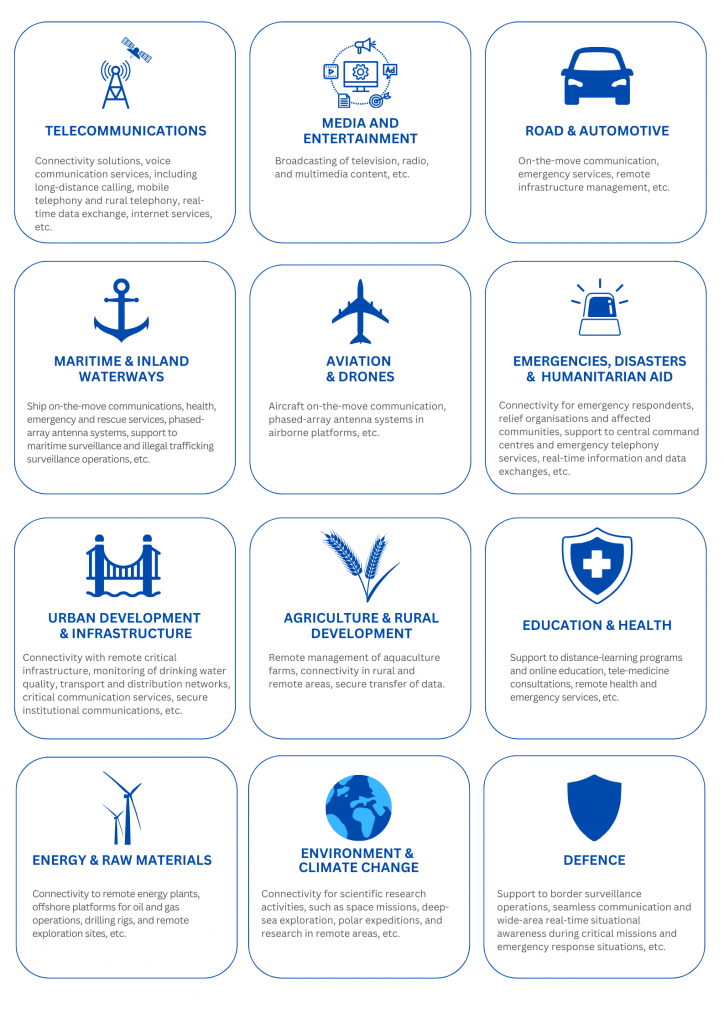SatCom Uses
Global SatCom Downstream Market
The global satellite communications (SatCom) market, including services and equipment, is expected to show significant increases in revenues and demand in the next decade. The global market size for SatCom equipment (e.g. antennas, transmitters/transponders, receivers, modems/routers, user terminals, monitoring systems, and network infrastructure) was valued at USD 21.37 billion in 2022 and it is expected to reach USD 52.87 billion by 2032, with the market growing at a CAGR of 9.5% from 2022 to 2032 (Ref). SatCom service revenues are also expected to grow, reaching EUR 126 billion by 2025 (Ref).
This expansion follows a phase of substantial investments in satellite infrastructure, with the development of new non-geostationary orbit constellations (particularly in the low Earth orbit) and of optical satellite communications.
Satellite communications are already crucial to ensure wireless communications in rural and remote areas, to ensure voice communication services regardless of terrestrial network coverage, and to provide broadband internet access to residential users, businesses, educational institutions, and government organisations worldwide.
In the coming decade, the increasing demand for SatCom equipment and services is expected to be particularly propelled by the growth of the telecommunication industry, and the increasing demand for SatComs in disaster management and emergency response and for research and R&D activities. Key drivers of the expected market expansion will be universal broadband access, mobility (including air, maritime and land), and applications related to defence and security.
SatCom Market Sectors and Applications
Some key Satcom market sectors and applications include:

European SatCom
The European Union is working on the deployment of GOVSATCOM, a component already part of the EU Space Regulation (2021), while preparing the ground for the ambitious IRIS², the new EU Secure Connectivity Programme. Those systems will complement the EU Space Programme and its components for Navigation (Galileo and EGNOS), Earth Observation (Copernicus) and Space Situational Awareness (Ref).
GOVSATCOM
The European Union Governmental Satellite Communications (GOVSATCOM) programme aims at providing secure and cost-efficient communications capabilities to security and safety critical missions and operations managed by the European Union and its Member States, including national security actors and EU Agencies and institutions.
GOVSATCOM may generate up to 5,000 jobs in the EU and the impact of the programme will be felt by industries far beyond what it is normally considered as the space sector (Ref).
IRIS²
The IRIS² Satellite Constellation (Infrastructure for Resilience, Interconnectivity and Security by Satellite) is the new EU Secure Satellite Constellation offering enhanced communication capacities to governmental users and businesses, while ensuring high-speed internet broadband to cope with connectivity dead zones.
IRIS² will support a diverse range of governmental applications, primarily in the domains of surveillance (e.g., border surveillance), crisis management (e.g., humanitarian aid), and the connection and protection of key infrastructure (e.g., secure communications for EU embassies). In addition, it will also facilitate mass-market applications, including mobile and fixed broadband satellite access, satellite trunking for B2B services, satellite access for transportation, reinforced networks via satellite, and satellite broadband and cloud-based services.